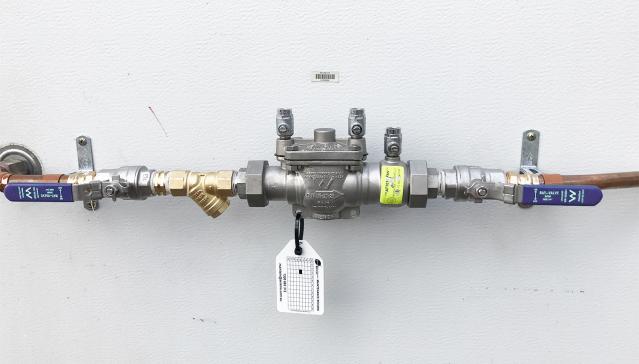Most Frequently Asked Questions about the Cross Connection Control Program and Backflow Prevention
Why does Texas Water need a Cross-Connection Control and Backflow Prevention Program?
The program safeguards the public drinking water and protects the health of its customers by ensuring that any contaminants that could backflow into the public water supply system are isolated within the customer's internal distribution system.
What is a Cross-Connection?
Cross-connections are the physical links that allow backflow to occur. Through physical connections, contamination of the water supply is possible due to backpressure or backsiphonage. Cross-connections are so common that they may go unnoticed and unrecognized. Recognition of common cross-connections is important to eliminate the potential for contamination of the public water supply.
What is a Customer Service Inspection (CSI)?
Inspectors will check to make sure there are no direct connections between the public drinking water supply and a potential source of contamination or private water system that is not protected by either an air gap or an appropriate backflow prevention assembly in accordance with TCEQ regulations. They will also ensure that no pipe or pipe fitting with more than 8% lead or solder with more than 0.2% lead exists.
When should a Customer Service Inspection (CSI) be performed?
CSIs are performed on new construction, existing services where contaminant hazards are suspected, and existing services where major renovations or expansion of the distribution facilities have occurred.
What is Backflow?
Backflow is an undesirable or unwanted reversal flow of used or non-potable water or substance from any domestic, industrial or institutional piping system into the potable water distribution system.
What is Backsiphonage?
Backsiphonage is the reverse pressure gradient due to a loss of pressure in the supply lines, caused by mainline breaks, use of fire hydrants, and other variables. The loss of pressure in the supply lines can cause water and other contaminants in the customer’s lines to be “sucked” back into the public water supply, similar to drinking out of a straw.
What is Backpressure?
Backpressure is the flow from a customer’s higher pressure system through an unprotected cross-connection. Many forces can create backpressure, including centrifugal and positive displacement pumps, higher elevation water, pressurized vessels, boilers, or steam systems, and heating or freezing water in closed fluid-filled pipes or containers.
How do you prevent backflow?
The two main ways to prevent backflow are: to install a backflow prevention assembly or create an air gap.
What is an air gap?
An air gap is a physical separation of the public water supply from the source of the contamination. The air gap is provided by an unobstructed vertical separation of two times the diameter of the water supply outlet’s effective opening (but never less than one inch) between the discharge end of the water supply pipe and the flood level rim of the receptacle. Screened protection over the water supply outlet is recommended to protect the water supply pipe from insects and vermin. Caution must also be exercised if the tank receptacle contains substances that may emit toxic fumes or vapors which could be back siphoned into the freshwater supply line.
What is a backflow prevention assembly?
The basic mechanism for preventing backflow is a mechanical backflow preventer, which provides a physical barrier to backflow.
How do you protect a backflow prevention assembly?
Some backflow prevention assemblies are below ground while others are above ground; in either instance, it is important to properly insulate your device to protect them from freezing. You may refer to Freezing Temperatures for more information on how to protect outdoor fixtures.
You can also purchase insulated bags and/or insulated/decorative rocks to protect and conceal above-ground devices.
Why do backflow prevention assemblies need to be tested?
Mechanical backflow prevention assemblies have internal seals, springs, and moving parts that are subject to fouling, wear, or fatigue. Also, mechanical backflow preventers and air gaps can be bypassed. Therefore, all backflow prevention assemblies have to be tested periodically to ensure that they are functioning correctly.
How often does the backflow prevention assembly need to be tested?
In order to ensure the proper operation of a backflow prevention assembly, it must be tested and certified upon installation and at least once a year thereafter by a licensed backflow tester.
